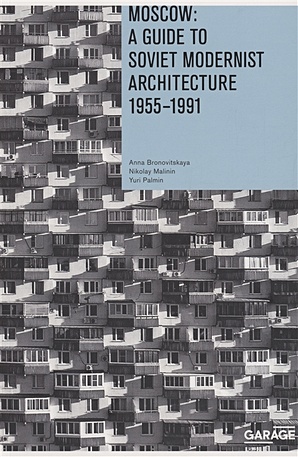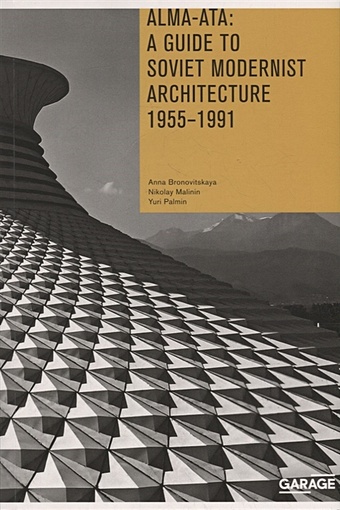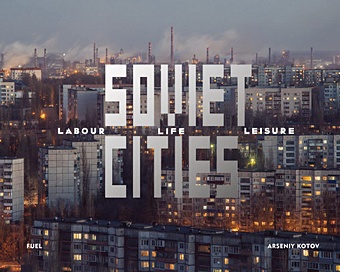bronovitskaya a malinin n palmin y moscow a guide to soviet modernist architecture 1955 1991

Bronovitskaya A., Malinin N., Palmin Y. Moscow: A guide to soviet modernist architecture 1955-1991
Moscow: A Guide to Soviet Modernist Architecture 1955-1991 provides descriptions of almost 100 buildings from the most underrated period of Soviet architecture. This is the first guide to bring together the architecture made during the three decades between Khrushchev and Gorbachev, from the naive modernism of the "thaw" of the late 1950s through postmodernism. Buildings include the Palace of Youth, the Rossiya cinema, the Pioneer Palace, the Ostankino TV Tower, the TASS headquarters, the "golden brains" of the Academy of Sciences and less well-known structures such as the House of New Life and the Lenin Komsomol Automobile Plant Museum. The authors situate Moscow's postwar architecture within the historical and political context of the Soviet Union, while also referencing developments in international architecture of the period.
1601 Руб.

Bronovitskaya A., Malinin N., Palmin Y. Moscow: A guide to soviet modernist architecture 1955-1991
Moscow: A Guide to Soviet Modernist Architecture 1955-1991 provides descriptions of almost 100 buildings from the most underrated period of Soviet architecture. This is the first guide to bring together the architecture made during the three decades between Khrushchev and Gorbachev, from the naive modernism of the "thaw" of the late 1950s through postmodernism. Buildings include the Palace of Youth, the Rossiya cinema, the Pioneer Palace, the Ostankino TV Tower, the TASS headquarters, the "golden brains" of the Academy of Sciences and less well-known structures such as the House of New Life and the Lenin Komsomol Automobile Plant Museum. The authors situate Moscow's postwar architecture within the historical and political context of the Soviet Union, while also referencing developments in international architecture of the period.
1601 Руб.

Bronovitskaya Anna, Malinin Nikolay, Palmin Yiri Moscow. A Guide to Soviet Modernist Architecture 1955-1991
Moscow: A Guide to Soviet Modernist Architecture 1955-1991 provides descriptions of almost 100 buildings from the most underrated period of Soviet architecture. This is the first guide to bring together the architecture made during the three decades between Khrushchev and Gorbachev, from the naive modernism of the "thaw" of the late 1950s through postmodernism. Buildings include the Palace of Youth, the Rossiya cinema, the Pioneer Palace, the Ostankino TV Tower, the TASS headquarters, the "golden brains" of the Academy of Sciences and less well-known structures such as the House of New Life and the Lenin Komsomol Automobile Plant Museum. The authors situate Moscow's postwar architecture within the historical and political context of the Soviet Union, while also referencing developments in international architecture of the period.
2571 Руб.

Bronovitskaya A., Malinin N. Alma-Ata: A Guide to Soviet Modernist Architecture. 1955-1991
Almaty became the capital of Soviet modernism after it ceased to be Alma-Ata, as its former rivals in terms of architecture—Yerevan and Kyiv, Tashkent and Minsk—gradually lost the heritage of the period dating from the 1960s through the 1980s. The losses in Almaty were not so serious. In 1997, the capital moved to Astana, which took on the architectural representation of independent Kazakhstan. Almaty remained a working museum of Soviet modernism, where one can see the first transparent library in the world, the first postmodernist skyscraper in the USSR, and a dam constructed using the most powerful controlled explosion in history. Authors Anna Bronovitskaya and Nikolay Malinin present the architecture of the city within the broad context of art, culture, and social and political history. This book is the second in a series launched in 2016 with a guidebook to Moscow's Soviet modernist architecture. "From the 1960s through the 1980s, Alma-Ata saw the emergence of a unique blend of international modernism, Soviet colonialism, and attempts by architects to enrich the language of modernism with Kazakh national traditions. Thanks to this book I discovered a completely unfamiliar stratum of postwar Soviet architecture." Vladimir Paperny UCLA
3249 Руб.

Bronovitskaya A., Malinin N. Alma-Ata: A Guide to Soviet Modernist Architecture. 1955-1991
Almaty became the capital of Soviet modernism after it ceased to be Alma-Ata, as its former rivals in terms of architecture—Yerevan and Kyiv, Tashkent and Minsk—gradually lost the heritage of the period dating from the 1960s through the 1980s. The losses in Almaty were not so serious. In 1997, the capital moved to Astana, which took on the architectural representation of independent Kazakhstan. Almaty remained a working museum of Soviet modernism, where one can see the first transparent library in the world, the first postmodernist skyscraper in the USSR, and a dam constructed using the most powerful controlled explosion in history. Authors Anna Bronovitskaya and Nikolay Malinin present the architecture of the city within the broad context of art, culture, and social and political history. This book is the second in a series launched in 2016 with a guidebook to Moscow's Soviet modernist architecture. "From the 1960s through the 1980s, Alma-Ata saw the emergence of a unique blend of international modernism, Soviet colonialism, and attempts by architects to enrich the language of modernism with Kazakh national traditions. Thanks to this book I discovered a completely unfamiliar stratum of postwar Soviet architecture." Vladimir Paperny UCLA
3249 Руб.

Bronovitskaya Anna, Malinin Nikolay, Palmin Yiri Alma-Ata. A Guide to Soviet Modernist Architecture. 1955-1991
В книгу историков архитектуры Анны Броновицкой и Николая Малинина и фотографа Юрия Пальмина вошло более 60 объектов - от цирка и рынка до дворцов культуры и жилья - в самых разных архитектурных стилях, созданных между хрущевской реформой и распадом СССР. Анна Броновицкая и Николай Малинин рассматривают каждое здание в широком контексте культурной, социальной и политической истории. В своем исследовании авторы опирались как на документы, так и на интервью с алма-атинскими архитекторами, историками, сегодняшними и бывшими жителями города. Фотосъемка Юрия Пальмина, выявляющая эстетику построек или фиксирующая их искажения, дополнена богатым архивным материалом - чертежами, проектными перспективами, историческими фотографиями. Архитектурный путеводитель можно рассматривать и как книгу об истории "золотого века" старой столицы Казахстана, интернационального и просвещенного города со своим неповторимым лицом, притягивавшего талантливых архитекторов и художников из разных концов Советского Союза. Сегодня Алма-Ату можно назвать "столицей советского модернизма". Если былые соперники по части архитектуры - Ереван и Киев, Ташкент и Минск - растеряли наследие 1960-1980-х, в Алма-Ате оно не понесло столь тяжких утрат: в 1997 году столичные функции были передоверены Астане, которая и занялась архитектурной репрезентацией независимого Казахстана. Алма-Ата же остается действующим музеем советского модернизма, где можно увидеть и первую в мире прозрачную библиотеку, и первый в СССР постмодернистский небоскреб, и плотину, построенную самым мощным в истории направленным взрывом. Издание на английском языке.
1985 Руб.

Anna Bronovitskaya. Alma-Ata. A Guide to Soviet Modernist Architecture. 1955-1991
В книгу историков архитектуры Анны Броновицкой и Николая Малинина и фотографа Юрия Пальмина вошло более 60 объектов - от цирка и рынка до дворцов культуры и жилья - в самых разных архитектурных стилях, созданных между хрущевской реформой и распадом СССР. Анна Броновицкая и Николай Малинин рассматривают каждое здание в широком контексте культурной, социальной и политической истории. В своем исследовании авторы опирались как на документы, так и на интервью с алма-атинскими архитекторами, историками, сегодняшними и бывшими жителями города. Фотосъемка Юрия Пальмина, выявляющая эстетику построек или фиксирующая их искажения, дополнена богатым архивным материалом - чертежами, проектными перспективами, историческими фотографиями. Архитектурный путеводитель можно рассматривать и как книгу об истории "золотого века" старой столицы Казахстана, интернационального и просвещенного города со своим неповторимым лицом, притягивавшего талантливых архитекторов и художников из разных концов Советского Союза.Сегодня Алма-Ату можно назвать "столицей советского модернизма". Если былые соперники по части архитектуры - Ереван и Киев, Ташкент и Минск - растеряли наследие 1960-1980-х, в Алма-Ате оно не понесло столь тяжких утрат: в 1997 году столичные функции были передоверены Астане, которая и занялась архитектурной репрезентацией независимого Казахстана. Алма-Ата же остается действующим музеем советского модернизма, где можно увидеть и первую в мире прозрачную библиотеку, и первый в СССР постмодернистский небоскреб, и плотину, построенную самым мощным в истории направленным взрывом.Издание на английском языке.
2650 Руб.

Conte Roberto, Perego Stefano Soviet Asia. Soviet Modernist Architecture in Central Asia
A fantastic collection of Soviet Asian architecture, many photographed here for the first time Soviet Asia explores the Soviet modernist architecture of Central Asia. Italian photographers Roberto Conte and Stefano Perego crossed the former Soviet republics of Kazakhstan, Kyrgyzstan, Uzbekistan and Tajikistan, documenting buildings constructed from the 1950s until the fall of the USSR. The resulting images showcase the majestic, largely unknown, modernist buildings of the region. Museums, housing complexes, universities, circuses, ritual palaces - all were constructed using a composite aesthetic. Influenced by Persian and Islamic architecture, pattern and mosaic motifs articulated a connection with Central Asia. Grey concrete slabs were juxtaposed with colourful tiling and rectilinear shapes broken by ornate curved forms: the brutal designs normally associated with Soviet-era architecture were reconstructed with Eastern characteristics. Many of the buildings shown in Soviet Asia are recorded here for the first time, making this book an important document, as despite the recent revival of interest in Brutalist and Modernist architecture, a number of them remain under threat of demolition. The publication includes two contextual essays, one by Alessandro De Magistris (architect and History of Architecture professor, University of Milan, contributor to the book Vertical Moscow) and the other by Marco Buttino (Modern and Urban History professor, University of Turin, specializing in the history of social change in the USSR).
7394 Руб.

Soviet Asia: Soviet Modernist Architecture in Central Asia
Soviet Asia explores the Soviet modernist architecture of Central Asia. Italian photographers Roberto Conte and Stefano Perego crossed the former Soviet republics of Kazakhstan, Kyrgyzstan, Uzbekistan and Tajikistan, documenting buildings constructed from the 1950s until the fall of the USSR. The resulting images showcase the majestic, largely unknown, modernist buildings of the region. Museums, housing complexes, universities, circuses, ritual palaces―all were constructed using a composite aesthetic. Influenced by Persian and Islamic architecture, pattern and mosaic motifs articulated a connection with Central Asia. Gray concrete slabs were juxtaposed with colourful tiling and rectilinear shapes broken by ornate curved forms: the brutal designs normally associated with Soviet-era architecture were reconstructed with Eastern characteristics. Many of the buildings shown in Soviet Asia are recorded here for the first time, making this book an important document, as, despite the recent revival of interest in Brutalist and modernist architecture, a number of them remain under threat of demolition. The publication includes two contextual essays by Alessandro De Magistris and Marco Buttino.
4590 Руб.

Sobecka (Zupagrafika) Martyna Concrete Siberia. Soviet Landscapes of the Far North
A photographic insight into the Soviet-era architecture of one of the most extreme, little-known and vast territories on Earth. From the Ural Mountains to the Arctic Circle, Concrete Siberia by Zupagrafika contains over 100 photographs exploring the post-war modernist districts of Siberia's urban centres and the quotidian lives of their inhabitants.
6522 Руб.

Kotov Arseny Soviet Cities. Labour, Life & Leisure
The Soviet dream of modernist architecture for all, portrayed on the brink of its erasure In recent years Russian cities have visibly changed. The architectural heritage of the Soviet period has not been fully acknowledged. As a result many unique modernist buildings have been destroyed or changed beyond recognition. Russian photographer Arseniy Kotov intends to document these buildings and their surroundings before they are lost forever. He likes to take pictures in winter, during the “blue hour,” which occurs immediately after sunset or just before sunrise. At this time, the warm yellow colors inside apartment-block windows contrast with the twilight gloom outside. To Kotov, this atmosphere reflects the Soviet period of his imagination. His impression of this time is unashamedly idealistic: he envisages a great civilization, built on a fair society, which hopes to explore nature and conquer space. From the Baikonur Cosmodrome in the desert steppes of Kazakhstan to the grim monolithic high-rise dormitory blocks of inner-city Volgograd, Kotov captures the essence of the post-Soviet world. “The USSR no longer exists and in these photographs we can see what remains?the most outstanding buildings and constructions, where Soviet people lived and how Soviet cities once looked: no decoration, no bright colors and no luxury, only bare concrete and powerful forms.” This superbly designed volume is the latest in Fuel's revelatory and inspiring series on Soviet-era architecture.
3842 Руб.

Мюррэй Д., Соррелл С. Soviet Cities: Labour, Life & Leisure
The Soviet dream of modernist architecture for all, portrayed on the brink of its erasureIn recent years Russian cities have visibly changed. The architectural heritage of the Soviet period has not been fully acknowledged. As a result many unique modernist buildings have been destroyed or changed beyond recognition.Russian photographer Arseniy Kotov intends to document these buildings and their surroundings before they are lost forever. He likes to take pictures in winter, during the “blue hour,” which occurs immediately after sunset or just before sunrise. At this time, the warm yellow colors inside apartment-block windows contrast with the twilight gloom outside. To Kotov, this atmosphere reflects the Soviet period of his imagination. His impression of this time is unashamedly idealistic: he envisages a great civilization, built on a fair society, which hopes to explore nature and conquer space.From the Baikonur Cosmodrome in the desert steppes of Kazakhstan to the grim monolithic high-rise dormitory blocks of inner-city Volgograd, Kotov captures the essence of the post-Soviet world. “The USSR no longer exists and in these photographs we can see what remains?the most outstanding buildings and constructions, where Soviet people lived and how Soviet cities once looked: no decoration, no bright colors and no luxury, only bare concrete and powerful forms.”This superbly designed volume is the latest in Fuel's revelatory and inspiring series on Soviet-era architecture.
4148 Руб.

Мюррэй Д., Соррелл С. Soviet Cities: Labour, Life & Leisure
The Soviet dream of modernist architecture for all, portrayed on the brink of its erasureIn recent years Russian cities have visibly changed. The architectural heritage of the Soviet period has not been fully acknowledged. As a result many unique modernist buildings have been destroyed or changed beyond recognition.Russian photographer Arseniy Kotov intends to document these buildings and their surroundings before they are lost forever. He likes to take pictures in winter, during the “blue hour,” which occurs immediately after sunset or just before sunrise. At this time, the warm yellow colors inside apartment-block windows contrast with the twilight gloom outside. To Kotov, this atmosphere reflects the Soviet period of his imagination. His impression of this time is unashamedly idealistic: he envisages a great civilization, built on a fair society, which hopes to explore nature and conquer space.From the Baikonur Cosmodrome in the desert steppes of Kazakhstan to the grim monolithic high-rise dormitory blocks of inner-city Volgograd, Kotov captures the essence of the post-Soviet world. “The USSR no longer exists and in these photographs we can see what remains?the most outstanding buildings and constructions, where Soviet people lived and how Soviet cities once looked: no decoration, no bright colors and no luxury, only bare concrete and powerful forms.”This superbly designed volume is the latest in Fuel's revelatory and inspiring series on Soviet-era architecture.
4148 Руб.

Sobecka (Zupagrafika) Martyna Eastern Blocks. Concrete Landscapes of the Former Eastern Bloc
Eastern Blocks by Zupagrafika is a photographic journey through the cityscapes the former Eastern Bloc, inviting readers to explore the districts and peripheries that became a playground for mass housing development after WW2, including objects like Soviet ‘flying saucers’, houses ‘on chicken legs’ or hammer-shaped tower blocks. Showcasing modernist and brutalist architecture scattered around the cities of Moscow, (East) Berlin, Warsaw, Budapest, Kyiv and Saint Petersburg, the book contains over 100 photographs taken by Zupagrafika throughout the last decade as a reference archive for their illustrated kits and books, with special contributions by local photographers. Divided into 6 chapters, Eastern Blocks includes a foreword by writer and journalist Christopher Beanland, orientative maps, index of architects and informative texts on the featured cities and constructions.
6763 Руб.
Alexander Veryovkin. Eastern Blocks: Concrete Landscapes of the Former Eastern Bloc
Eastern Blocks by Zupagrafika is a photographic journey through the cityscapes of the former Eastern Bloc, inviting readers to explore the districts and peripheries that became a playground for mass housing development after WW2, including objects like Soviet 'flying saucers', houses 'on chicken legs' or hammer-shaped tower blocks.Showcasing modernist and brutalist architecture scattered around the cities of Moscow, (East) Berlin, Warsaw, Budapest, Kyiv and Saint Petersburg, the book contains over 100 photographs taken by Zupagrafika throughout the last decade as a reference archive for their illustrated kits and books, with special contributions by local photographers. Divided into 6 chapters, Eastern Blocks includes a foreword by writer and journalist Christopher Beanland, orientative maps, index of architects and informative texts on the featured cities and constructions.
4499 Руб.

Deyan Sudjic. Imagine Moscow: Architecture, Propaganda, Revolution
After the October Revolution of 1917, Lenin moved the Russian capital from the imperial, westward-looking city of St. Petersburg back to Moscow, the traditional heart of Russia. Moscow was to be the ideal Soviet city, its factories, theaters, communal housing and government buildings representing the strength and potential of a new revolutionary society. Imagine Moscow: Architecture, Propaganda, Revolution explores Moscow as it was envisioned by a bold generation of architects in the 1920s and early 1930s. Featuring rarely seen material, this book portrays a vision of the Soviet capital that was never realized but which still haunts the city today. Imagine Moscow focuses on six unbuilt architectural landmarks, each telling its own story about the city: Ivan Leonidov's Lenin Institute (1927), El Lissitzky's “Cloud Iron" (1924), Nikolai Ladovsky's Communal House (1919), Nikolai Sokolov's Health Factory (1927), the Vesnin brothers' Narkomtiazhprom (1934) and Boris Iofan's Palace of the Soviets (1932). Each of these projects introduces a theme relevant to life and ideology in the Soviet Union: collectivization, urban planning, aviation, communication, industrialization, communal living and recreation. Large-scale architectural plans, models and drawings are placed alongside propaganda posters, textiles and porcelain, contextualizing the transformation of Moscow as a city reborn. Edited by curator Eszter Steierhoffer, this book includes essays by writer Deyan Sudjic and architecture historians Richard Anderson and Jean-Louis Cohen.
2230 Руб.